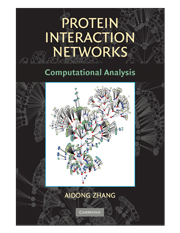Book contents
- Frontmatter
- Contents
- Preface
- 1 Introduction
- 2 Experimental Approaches to Generation of PPI Data
- 3 Computational Methods for the Prediction of PPIs
- 4 Basic Properties and Measurements of Protein Interaction Networks
- 5 Modularity Analysis of Protein Interaction Networks
- 6 Topological Analysis of Protein Interaction Networks
- 7 Distance-Based Modularity Analysis
- 8 Graph-Theoretic Approaches to Modularity Analysis
- 9 Flow-Based Analysis of Protein Interaction Networks
- 10 Statistics and Machine Learning Based Analysis of Protein Interaction Networks
- 11 Integration of GO into the Analysis of Protein Interaction Networks
- 12 Data Fusion in the Analysis of Protein Interaction Networks
- 13 Conclusion
- Bibliography
- Index
1 - Introduction
Published online by Cambridge University Press: 28 January 2010
- Frontmatter
- Contents
- Preface
- 1 Introduction
- 2 Experimental Approaches to Generation of PPI Data
- 3 Computational Methods for the Prediction of PPIs
- 4 Basic Properties and Measurements of Protein Interaction Networks
- 5 Modularity Analysis of Protein Interaction Networks
- 6 Topological Analysis of Protein Interaction Networks
- 7 Distance-Based Modularity Analysis
- 8 Graph-Theoretic Approaches to Modularity Analysis
- 9 Flow-Based Analysis of Protein Interaction Networks
- 10 Statistics and Machine Learning Based Analysis of Protein Interaction Networks
- 11 Integration of GO into the Analysis of Protein Interaction Networks
- 12 Data Fusion in the Analysis of Protein Interaction Networks
- 13 Conclusion
- Bibliography
- Index
Summary
RAPID GROWTH OF PROTEIN-PROTEIN INTERACTION DATA
Since the sequencing of the human genome was brought to fruition, the field of genetics now stands on the threshold of significant theoretical and practical advances. Crucial to furthering these investigations is a comprehensive understanding of the expression, function, and regulation of the proteins encoded by an organism. This understanding is the subject of the discipline of proteomics. Proteomics encompasses a wide range of approaches and applications intended to explicate how complex biological processes occur at a molecular level, how they differ in various cell types, and how they are altered in disease states.
Defined succinctly, proteomics is the systematic study of the many and diverse properties of proteins with the aim of providing detailed descriptions of the structure, function, and control of biological systems in health and disease. The field has burst onto the scientific scene with stunning rapidity over the past several years. Figure 1–1 shows the trend of the number of occurrences of the term “proteome” found in PubMed bioinformatics citations over the past decade. This figure strikingly illustrates the rapidly increasing role played by proteomics in bioinformatics research in recent years.
A particular focus of the field of proteomics is the nature and role of interactions between proteins. Protein-protein interactions (PPIs) regulate a wide array of biological processes, including transcriptional activation/repression; immune, endocrine, and pharmacological signaling; cell-to-cell interactions; and metabolic and developmental control. PPIs play diverse roles in biology and differ based on the composition, affinity, and lifetime of the association.
- Type
- Chapter
- Information
- Protein Interaction NetworksComputational Analysis, pp. 1 - 10Publisher: Cambridge University PressPrint publication year: 2009
- 6
- Cited by



